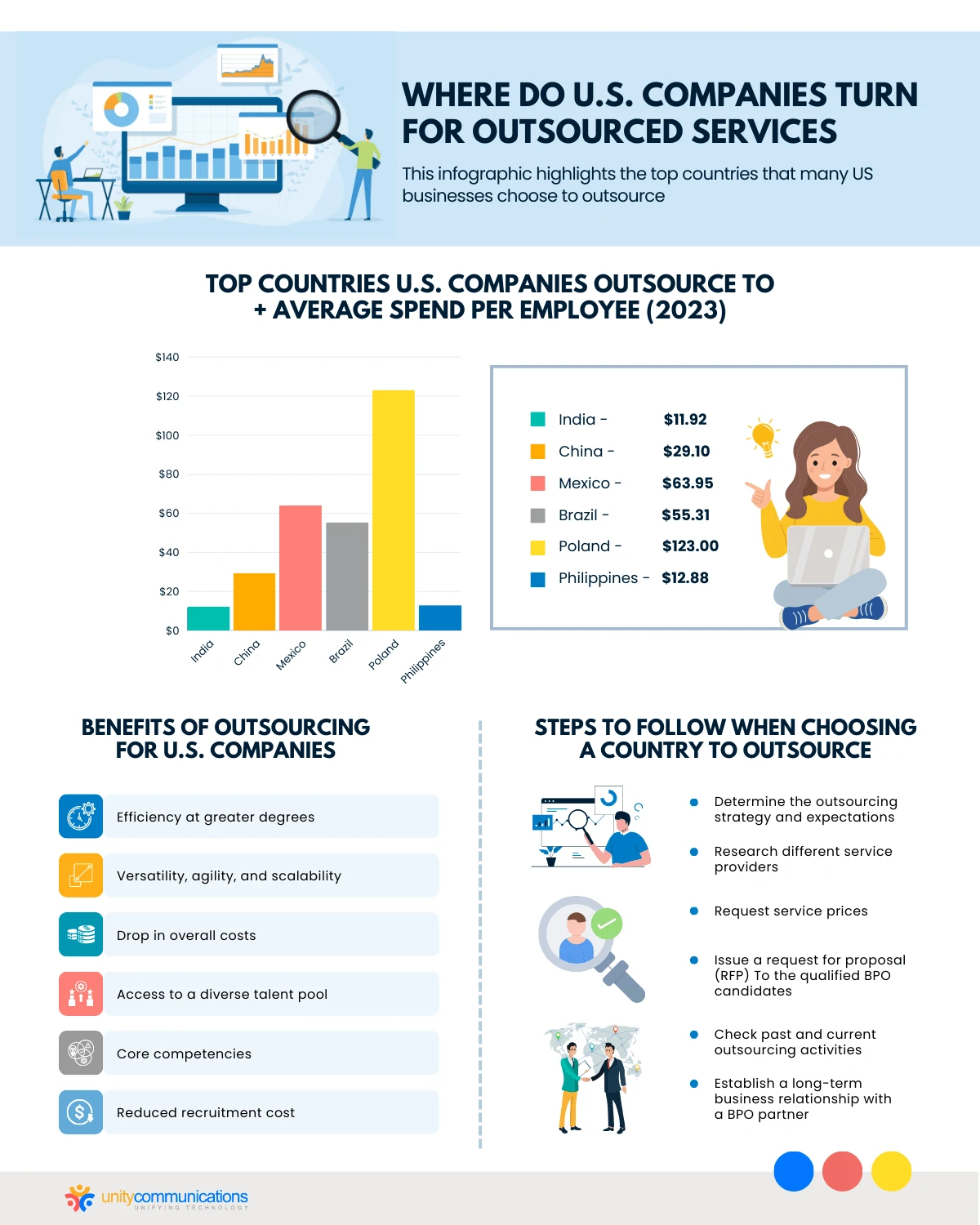Table of Contents
Many business process outsourcing (BPO) companies offer services to enterprises in the United States. These service providers manage various processes, such as sales support, help desks, and customer service, to help fulfill the client’s business goals.
So where do U.S. enterprises delegate their business functions?
This article discusses the countries that U.S. companies commonly outsource to. It also explains the benefits, challenges, and best practices for outsourcing. Let us dive in.
Which Countries Do U.S. Companies Outsource To?
The top countries that U.S. businesses outsource to are India, China, Mexico, Brazil, Poland, and the Philippines. Let us discover the details:
| Country | Region | Outsourcing Benefits | Outsourcing Challenges |
|---|---|---|---|
| India | South Asia | – Touted as the world’s leading information technology (IT) outsourcing destination – Offers low-cost, technically skilled, and English-speaking IT professionals | – At least nine hours ahead of the U.S. – Tracking outsourced services is difficult due to geographical and time zone differences. |
| China | East Asia | – Has the lowest wage costs for labor-intensive industries (e.g., manufacturing and production) – Provides the biggest workforce among outsourcing nations | – Lacks English proficiency compared to counterparts – Offers lower product or service quality than competitors |
| Mexico | North America | – The nearest outsourcing hub to the U.S., enabling higher control of outsourced processes – Has the best business relationships with the U.S. of all the outsourcing destinations | – Possesses low English proficiency despite being the closest to the U.S. – Has one of Latin America’s highest cybercrime incidences |
| Brazil | South America | – Delivers bilingual customer or technical support for English and Spanish consumers – Provides a large, highly educated, IT-competent, and English-speaking workforce | – Offers higher outsourcing fees than India, the Philippines, Mexico, and China – Has one of Latin America’s highest cybercrime rates, next to Mexico. |
| Poland | Eastern Europe | – Regarded as the outsourcing hub with the most English-proficient professionals – Has Europe’s best software developers | – Has the highest cost for outsourced services |
| Philippines | Southeast Asia | – Deemed as the world’s top call center outsourcing site – Provides affordable, technically proficient, and English-speaking customer service professionals | – Possesses the widest time zone discrepancy, no less than 12 hours ahead of the U.S. – Monitoring outsourced operations is challenging because of the large time gap and physical distance from the U.S. |
Overview of the BPO Industry in Countries U.S. Companies Outsource To
The following are some statistics on the world’s leading outsourcing markets:
BPO Industry’s Projected Revenue and Average Spend per Employee: By Country
| Country | Projected Revenue (2023) in U.S. Dollar | Projected Compound Annual Growth Rate (CAGR) and Market Volume by 2028 | Average Spend per Employee (2023) |
|---|---|---|---|
| India | $6.19 billion | 10.94%, $10.41 billion | $11.92 |
| China | $23.13 billion | 8.87%, $34.38 billion | $29.10 |
| Mexico | $3.87 billion | 4.86%, $4.90 billion | $63.95 |
| Brazil | $6.06 billion | 5.95%, $8.09 billion | $55.31 |
| Poland | $2.17 billion | 5.26%, $2.80 billion | $123.00 |
| Philippines | $0.62 billion | 9.03%, $0.96 billion | $12.88 |
Source: Statista
Based on the numbers above, India will register a double-digit growth rate from 2023 to 2027. Of all the countries U.S. companies outsource to, India and the Philippines have the lowest estimated average spend per employee in 2023, at $11.92 and $12.88, respectively.
Benefits of Outsourcing for U.S. Companies

Call center, virtual assistance, data entry offshoring services, there could be various tasks the US companies outsource to different countries, and they do so for different reasons. The following are reasons American businesses frequently approach service providers in other nations for outsourcing deals:
- Efficiency at greater degrees. Allowing a third-party team to assist with procedures reduces delays, inconsistencies, mistakes, and losses. Improved effectiveness and output indicate better customer service and product or service quality.
- Versatility, agility, and scalability. What is the BPO’s role in scaling processes? A third-party provider can supply skilled workers for outsourced activities. It can change the team size without disrupting work. It can also decrease the staff size so that you can save money.
- Drop in overall costs. Outsourcing converts fixed expenditures into variable costs. This reduces overhead expenses and capital investments, resulting in significant cost savings. The additional funds can then be used for other company purposes.
- Access to a diverse talent pool. The BPO provider has broad connections, enabling you to pick the most qualified professionals. It also has an ample reserve of experts or specialists that it can field to perform duties immediately. This is one reason vendors in different countries are ideal partners for U.S. companies seeking to outsource.
- Core competencies. Using a third-party provider to manage non-core company duties frees up resources for more profitable initiatives, such as product or service advancement, promotional activities, and development efforts. Outsourcing can help you achieve a competitive edge by allowing you to focus more on your core business tasks.
- Reduced recruitment cost. Finding suitable applicants, vetting and speaking with candidates, and hiring and instructing workers are expensive. These procedures involve additional energy, money, and time. The BPO provider can carry out these activities by sourcing and recruiting qualified candidates for the vacant roles.
Choosing a Country for U.S. Companies To Outsource To
The following are recommended steps when selecting a country for U.S. companies to outsource to:
1. Determine the Outsourcing Strategy and Expectations
Create a strategy before collaborating with an outsourcing company. Specify the motivations for outsourcing. Listed below are a few examples of potential objectives:
- To decrease operating expenses and achieve better cost savings
- To concentrate more on the core business to get a competitive advantage
- To obtain the latest technologies to build and maintain high-quality products or services
- To improve customer loyalty and retention to sustain sales growth
- To increase revenue and grow the business
- To be adaptable when dealing with unexpected challenges
2. Investigate Different Service Providers
Consider the following pointers when identifying an ideal country for U.S. companies to outsource their processes to:
- Research thoroughly. Gather necessary details on the prospective BPO partners. Consulting unbiased and neutral online sites and other trustworthy sources is best.
- Examine security measures. The potential service provider must have access to cutting-edge technology to protect vital corporate and client data.
- Pick a dedicated team. Find a BPO partner with a full-time third-party staff that exclusively works on the processes. Avoid using shared services as much as possible.
- Learn more about their competence. Know more about a prospect’s outsourcing experience and client list. Opt for BPO providers that are subject-matter experts.
3. Request Comprehensive Service Prices
Request that the prospects send a complete pricing list for offshore outsourcing or nearshoring services, including hidden or extra charges. Some providers might bill clients for additional activities not included in the terms of a BPO agreement. Be meticulous when studying their price offerings.
Service fees for BPO providers vary. Examine, contrast, and analyze the merits and cons of each pricing plan. Calculate the total cost. Reduce the list of prospects by picking candidates that minimize business expenses the most while maximizing potential income.
4. Issue a Request for Proposal (RFP) to the Qualified BPO Candidates
Draft and distribute an RFP to the short-listed applicants. An RFP is a document that collects price quotations from prospects, encouraging them to get involved in the bidding procedure. The objective is to secure the most affordable pricing and best available service.
Review the RFPs obtained from potential third-party providers. Accept the most suitable BPO bid and conclude the outsourcing deal with a service-level agreement (SLA). An SLA is a legal contract that specifies the services that the BPO partner must provide and the metrics or key performance indicators (KPIs) to regularly fulfill.
5. Check on Outsourced Activities
After selecting a BPO provider in a country most U.S. companies outsource to, integrate processes with the main organizational goals. Monitor the operations, performance, and production by employing these accepted measurements:
- Quantitative. This is used to track third-party teams’ progress using KPIs. Examples of KPIs are first response time, average resolution time, net promoter score, and customer satisfaction score.
- Qualitative. This refers to the BPO provider’s human resources knowledge regarding the client’s operations, services, and products. The third-party staff’s soft skills, including innovative thinking, problem-solving, and teamwork, are included in this statistic.
6. Establish a Long-Term Business Relationship with BPO Partner
Regular communication is crucial when working with service providers in countries where U.S. companies commonly outsource. Form and maintain a strong partnership with the third-party provider to raise the chances of hitting different outsourcing targets and objectives. The partner can help the business thrive, no matter the circumstances.
The Bottom Line

Outsourcing lowers costs, boosts output and efficiency, and improves earnings and the business edge. These advantages are obtained when collaborating with a respectable, dependable, and well-established BPO organization.
Before connecting with a BPO provider, consider all the best practices discussed. Outsourcing is a significant investment. If you utilize the proper technique, you can reap the rewards in the long term.
Let’s connect if you want to learn more about the top countries for U.S. companies planning to outsource!




